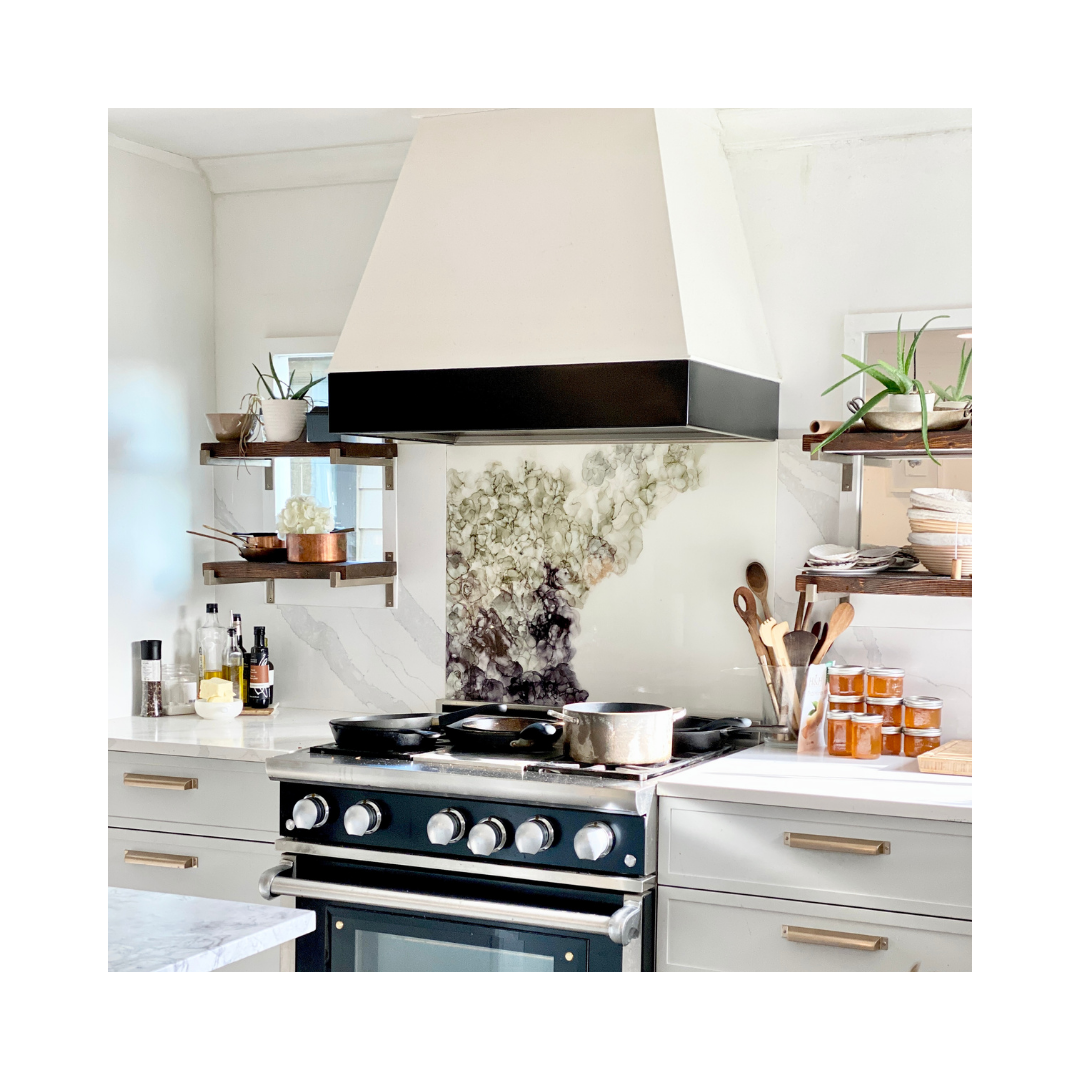Ventilation and Climate Control in Professional Home Kitchens
Ventilation systems include your main Cooking Zone but must be designed in coordination with the Kitchen space size, other heat, steam, grease and smoke bearing Appliances, openable windows, recovery air systems and existing A/C systems.
Proper air circulation and temperature management is an underrated but important consideration in Kitchen Design. Cooking inevitably creates smells, off-gases, grease, bacterias and even mold. If not planned for, the elements and surfaces in your Kitchen accumulate excessive dirt and grease that can lead to damage of tile work, mechanical equipment and other finishes. High-performance Appliances present even greater consideration in planning. High end Kitchen Designer Alison Kent specializes in creating optimized ventilation solutions for passionate home Cooks and Chefs at home. Booking a virtual consultation can help resolve complex airflow issues while ensuring cooking spaces maintain comfortable temperatures, leaving you with the best environment possible for your new Kitchen.
Kitchen Ventilation and Climate Control
- Smart range hood systems can automatically adjust airflow based on cooking intensity and temperature readings.
- Proper ventilation system sizing requires careful calculation of cooking equipment BTU and Watt ratings and Kitchen volume.
- Heat recovery ventilation units can reduce energy costs by up to 40% in professional home kitchens.
- Natural (windows, open spaces) and mechanical ventilation systems can work together to maintain optimal cooking environment conditions.
- Modern cooking methods like induction require less ventilation configurations, but various styles can be combined for both design flexibility and maximum effectiveness.
- Professional grade range hoods need specific ceiling heights and clearances for proper installation, and may require a make-up air system.
- Regular maintenance of ventilation sensors and filters ensures consistent air quality control.
Smart Range Hood Systems Transform Modern Residential Cooking Spaces
The first step with your main Cooking Zone is calculating the CFM requirements for your high-performance cooking zones. Home automation platforms with variable speed controls help to maintain air quality. Premium hood installation procedures maximize extraction in spacious kitchen layouts through strategic placement and sizing. Best of all, advanced noise reduction technology in luxury range hoods helps them operate at whisper-quiet levels while maintaining powerful suction capabilities.
Advanced Sensors Monitor Cooking Activities To Adjust Airflow Automatically
Thermal monitoring systems can now detect heat levels and adjust extraction power in real-time, while air quality detection sensors track particulate levels to optimize filtration settings automatically. Technology can help keep our Kitchens as clean and bacteria free as possible before we even start cleaning ourselves.
Essential Components of a Professional Kitchen Main Ventilation System
- Variable speed motor with minimum 600 CFM capacity
- Infrared temperature monitoring sensors
- Stainless steel baffle filters for grease extraction (some are even dishwasher friendly!)
- LED task lighting with dimming capabilities
- Makeup air damper system (to be planned with your Contractor when CFM capabilities are over 900 CFM)
- Digital control panel with WiFi connectivity
- Sound dampening technology package where available
- Where applicable/possible, placing louder motors on the exterior of the building
Professional Ventilation Requirements Shape Kitchen Space Planning
Higher ceilings create optimal conditions for professional ventilation equipment installation in luxury European-style kitchens. Clearance specifications ensure proper airflow - especially around commercial-grade cooking equipment, however your Designer can help balance this with appropriate ventilation heights above Cooking elements. Multiple cooking station arrangements require carefully calculated extraction placement for maximum effectiveness. Other Cooking Zones such as your wall ovens, steam ovens, microwaves, etc can be considered with a variety of Ventilation sytems.
Natural Ventilation Complements Mechanical Climate Control Systems
Passive airflow design strategies can reduce mechanical system requirements by 25%. Strategic window configurations maximize natural ventilation through stack effect principles. Thermal chimney installations enhance passive cooling capabilities during peak cooking times. Seasonal adjustments to hybrid ventilation strategies optimize year-round performance.
Expertly Positioned Windows Create Optimal Airflow Patterns
The best ventilation systems incorporate mechanical (hood fans and in home A/C units) and passive ventilation, which includes window openings for air, higher ceiling heights, and open plans. Window placement strategies at varying heights maximize natural ventilation effectiveness. Automated aperture control systems can enhance air circulation patterns throughout cooking zones, and help balance influxes of natural air with mechanical needs.
Kitchen Ventilation Standards Evolve With Modern Cooking Methods
Induction cooking systems require modified ventilation configurations for optimal performance. Specialized extraction systems adapt to various cooking styles, and various systems can be combined for low to higher volume cooking, depending on the day. International cooking methods, like wok or hibachi style cooking necessitate customized air handling solutions. Current ventilation technology trends also help focus on energy efficiency.
Why Are Ventilation Requirements Different For Various Cuisines?
High-heat wok cooking requires enhanced extraction capabilities with specialized hood designs. Gas elements can be as powerful as 36,000 BTU in home cooking tops. Commercial-grade smoker installations need dedicated ventilation modifications for proper operation. Deep frying activities demand increased air cleaning capacity and grease filtration. Molecular gastronomy equipment requires precise temperature and humidity control systems. All of these are great tools for a wide variety of cooking, but need careful consideration when planning. Your Contractor, Mechanical trade and Designer can work in coordination to help you achieve the best system solutions.
The Home Kitchen consulting services can help provide systems solutions for your Kitchens ventilation needs.

